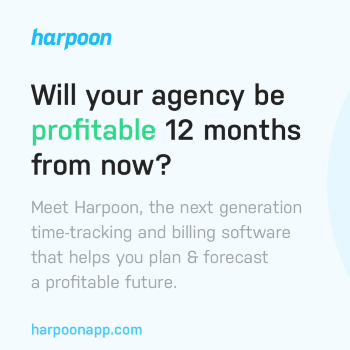Finding and hiring the right freelance talent for your agency can be challenging. From sifting through countless applications to vetting portfolios, the process of bringing on skilled professionals can feel overwhelming for many businesses.
But there’s one critical aspect of freelancer management that’s often overlooked: the onboarding process. Even after you’ve found great talent on platforms like Upwork, getting freelancers properly integrated into your team can make or break your working relationship.
In fact, poor onboarding can be detrimental to both parties. If freelancers don’t understand how to best serve your specific needs, there’s bound to be trial and error. This leads to frustration when projects don’t meet expectations, and you might assume the freelancer simply isn’t a good fit. When freelancers are let go or receive poor reviews, both your business and their career suffer from what was essentially a communication mismatch.
However, learning how to onboard freelancers to your agency could have solved this problem. Platforms like Upwork have made this process significantly easier, connecting businesses with talent and providing tools to manage the relationship from start to finish. According to research, 69% of employees who have a positive onboarding experience stay with employers for three years or longer. Startups can save 100-300% of their employee’s salary in turnover losses if they keep their employees.
The steps to hire a freelancer who won’t disappoint may be long, but they’re worth it. And with tools like Upwork streamlining the hiring process, it’s never been easier to find and properly integrate freelance talent into your team.
Here’s how to create an effective onboarding process that saves money and can help grow your company.
Step 1: Set your onboarding goals
The first step to learning how to onboard freelancers to your agency involves structure. A structured onboarding process is 58% more likely to set your freelancers up for success.
To create structure, you need to manage a program that revolves around the following key goals.
Impression: First impressions matter for both you and your employee. You can make a good first impression by completing your pre-onboarding checklist (in the next section), checking in regularly, and proving you’re trustworthy and professional. On Upwork, your company profile and job posting serve as your first impression, so make sure they accurately represent your brand.
Introduction: Next, you need to introduce your freelancers to your team and other key elements of your business. Use this chance to talk about your products and procedures.
Integration: An integrated freelancer is more focused on their role and department. This step typically occurs during the training phase of onboarding, which is also when freelancers discover how they fit in and how their work adds to the organization.
Immersion: An immersed freelancer will understand three key aspects of your startup’s culture: how your business functions, its processes, and the skills they need to succeed.
Global customers rely on Bloomberg Sources to deliver accurate, real-time business and market-moving information that helps them make critical financial decisions. Please contact: michael@
bloombergsources.com AdvertisementAdvertise HereIndependence: Clients should validate their freelancer’s skills to gauge if they can successfully work independently. On the other hand, freelancers should check that the work they’re performing for their clients meets a short-term or long-term goal.
In our next sections, we’ll look at these goals more in-depth and show you how to apply them.
Step 2: Complete your pre-onboarding checklist
If you’re completing the following tasks on day one, you’re already falling behind. It’s vital that you pre-onboard your freelancers, so they can get started on their work as soon as possible.
Freelancers often get paid per word or per project, meaning they’re losing money (and possibly their free time) if they have to complete early onboarding tasks after you assign them work. Start your relationship off right by showing you respect their time, hard work, and learned skills.
Here’s a checklist you should use to structure your pre-onboarding process:
Gather contracts, tax forms, and other relevant documents, such as the W-9 Form for freelancers. If you’re hiring through Upwork, many of these processes are handled automatically through their platform, saving you significant administrative time.
Share role-relevant information, like needed availability and your project policies.
Provide an itinerary for the first week to get them used to their daily schedule.
Set up a company email address, phone number, and login details for software. With Upwork’s built-in communication tools, you can easily share credentials securely.
Give them a checklist of assignments, project timelines, and goals for week 1.
Information about company events (i.e., award shows) and anniversaries.
Make a welcome kit full of company swag and mail it. You can use these gift ideas for staff appreciation, award shows, or to increase company-wide employee morale.
AdvertisementAdvertise HereAsk fellow employees to send a welcome email or video (either individual or in a group).
Reach out to address any questions or concerns before they start their first day.
- Schedule meet and greets with clients they’ll be working with (if applicable).
If all goes well, your freelancers should feel ready to start working in your company from day one.
Step 3: Communicate your company and business objectives
Brand messaging is just as important to freelancers as employees. Your hired freelancer won’t know every nuisance of your business, so they need to be educated on these core details.
To create a productive relationship, explain what your company sells, who it wants to reach, and how you plan on accomplishing its business goals. If anything changes, keep your freelancers up to date. Not only will this make your relationship productive, but you can also provide them with extra work. For example, they may need to update your policy or already posted content.
What are the benefits of communicating business objectives?
If a freelancer is only going to be with you for a limited time, is there really any reason to communicate your business objectives? Yes.
Here’s what you’ll gain from voicing your goals.
- Higher performance because everyone has a better understanding of ROI targets;
- Better project progress because everyone is on the same page at all times;
- Greater involvement because freelancer’s seen as a part of the overall plan and;
- Shared responsibility, because goals are interlinked across your company.
Freelancers love working with clients that are transparent, responsible, and honest about their objectives. A freelancer can’t give you the best work if they don’t know what you want. By supplying them with this information, you’ll instantly see an improvement in their projects.
Should you also pass on a style or pitch guide and a portfolio?
Ideally, you’ll have a style guide, pitch guide, and portfolio you can show to new freelancers. But if you’re a small business, you may be in the planning stages for your brand. If that’s the case, inform your freelancer that you’re not sure what you need, and you’ll need their help deciding.
Eventually, your freelancer may know your brand enough to create a style or pitch guide themselves, along with a portfolio of past work you can show to other freelancers. On Upwork, you can build a talent bench of trusted freelancers who understand your brand and can be called upon for future projects.
Step 4: Choose the right communication channels
To speak to your freelancers, you need to use tools they’re already using. Upwork provides a robust messaging system directly in its platform, making it simple to keep all project communications in one place. Beyond that, some examples include Slack for team communication, Asana for project management, and ZipMessage for video conferencing. These tools make client-to-freelancer communication simple and easy.
However, any tool will work if clients are able to:
- Listen and analyze their freelancer’s expectations for projects
- Be professional and answer questions in a reasonable timeframe
- Ask the right questions to ensure quality work is received
- Maintain contact regularly through one or two channels
- Be clear and concise when discussing project terms
With that said, there are specific communication channels that create the ideal space for clients and freelancers to communicate. We’ll look at a few perfect examples in the next section.

What makes a good communication channel?
A great communication channel benefits the client and the freelancer. However, communication channels intended for freelancers should respect the freelancer’s time and work preferences.
Freelancers prefer flexibility and over-communication because they can’t walk into your office at any time and ask questions. Everything should be available for them in writing, or at least recorded, so they can refer to this information at a later date. They also shouldn’t be expected to reply immediately, especially if they live in a different time zone or another country.
For these reasons, the following communication channels are the best options for freelancers:
- Pre-recorded video
- Direct emails
- Text messages
- Instant messaging
- Upwork’s built-in messaging system (which keeps all project communications centralized)
Video chat or conference calls can work if you plan multiple meetings or your team lives locally. However, you should limit these chats to make your communication style less time-strict.
If you want to know the secret to how to onboard freelancers to your agency successfully every time, using pre-recorded videos is key. Pre-recorded videos can streamline the process by removing time and location barriers. Plus, they can deliver the same message to new recruits.
Should message threads be visible to everyone?
That depends on what the message thread is for. If the message thread is for project-wide communication or for company-specific updates, then you should use a collaborative channel.
In fact, it’s in your best interest to centralize your online collaboration and communication as much as possible. Proper visibility ensures you’re not the sole message carrier for your team. Upwork’s Team feature allows you to organize freelancers into project-specific groups with shared visibility into communications.
However, you should also give freelancers a channel for non-project communication, as that can help build relationships between teams. If you’re in these channels, it may discourage your team from interacting. Give your freelancers space by setting up a private channel just for them.
What other technology and tools should you use?
Never assume that your freelancer is using the same tools as you, as it could create hiccups in your onboarding process. To keep problems at a minimum, send your freelancer a list of tools they need to perform their job correctly. Better yet, include these tools in your job description and during the initial setup phases in your client onboarding software. When you use Upwork, you can specify required tools and experience levels right in your job posting, ensuring you only connect with freelancers who are already familiar with your workflow.
While the tools you’ll need will depend on the type of freelancer you’ll hire and the projects they’ll complete, you may need to train them on the following tools before they get started:
- Accounting software (Check out FreshBooks or Quickbooks, though Upwork handles invoicing automatically)
- Time tracking software (Look at actiTime or Clockify, or use Upwork’s built-in time tracking)
- Project management software (Try Moxie or Monday.com)
- Customer relationship management software (Give Zoho a look)
- Website building software (Like WordPress)
- Payment transaction software (PayPal or Stripe, though Upwork securely handles all payments)
- Sales, marketing, and PR software (Marketo)
Another word of advice: secure company logins, and don’t share your password with freelancers, even if you’ve worked with them for a while. Create a new account for each freelancer to prevent possible security risks.
Step 5: Set communication and etiquette rules
Once you have your tools sorted, set your expectations for the type of communication you’ll have with your freelancer. Remember: if the project and your expectations are clear, freelancers will hand in your project sooner. You’ll also avoid upsetting your own clients if you have them.
Even learning how to onboard freelancers to your agency requires communication skills. If you want to onboard freelancers effectively, you need to ask them how they prefer to be spoken to.
Here are some communication and etiquette rules to consider:
- How do you expect to communicate with your freelancer?
- How often do you want to check-in for project updates?
- If the freelancer has to take time off, how much notice should they give?
- Are your freelancers joining existing teams? If so, how will you introduce them?
- Are there any communication hurdles to tackle (i.e., different time zones)?
- Who should the freelancer speak to if they have a problem?
- How should freelancers speak to coworkers? Professionally or casually?
- When can I communicate with freelancers? What hours are they available?
Online communication can be difficult if the right etiquette and communication rules aren’t in place. Establish these early so your freelancers don’t have to relearn new habits. Upwork offers tools to clearly outline these expectations within contracts and project milestones.
Step 6: Introduce freelancers to the right stakeholders
A stakeholder is anyone who’s directly involved or indirectly affected by your company’s projects. In a small startup, your stakeholders will include managers, coworkers, and clients.
Set up a welcome meeting
Book an initial kick-off meeting between the freelancer and their team. Most small teams should coordinate their schedules to meet on a single video call, as this saves time. If you have a team full of international freelancers, ask them to send a recorded video instead. The goal of these meetings is to help establish a personal connection between your team and the freelancer. Upwork makes scheduling these meetings simple with its integrated scheduling features.
Formally introduce managers
Small startups may only have a CEO as the acting manager. If that’s your setup, then there’s no need to introduce yourself twice. However, if your team has a specific manager that oversees their projects, be sure to book a separate meeting with their higher-ups or project managers.
Freelancers need to know where to go when they have questions or require support. Offering a one-on-one introduction allows freelancers to become familiar with who they’re reporting to.
Create guidelines for technical issues
Freelancers complete the majority of their work on the computer. At the very least, they need to send completed projects over the internet, but technical issues may prevent them from doing so. Be sure to walk them through any technical problems that may occur to reduce downtime.
Depending on the size of your startup, you may not have a documented troubleshooting or technical policy. But if you hire a technical writer through Upwork, you can ask them to make one for you!
Finalize payment terms and details
Freelancers should have payment terms in their contract that outline how they’ll be paid and when. However, if you want to set up a specific payment term or payout method, be sure to discuss this before the project begins, or you’ll have to abide by the signed contract’s terms. When you hire through Upwork, payments are handled securely through their platform, protecting both you and your freelancers with milestone-based payments and escrow services.
Step 7: Keep employees engaged and build relationships
The onboarding process doesn’t stop once your freelancers become immersed in your startup or are able to work independently. In fact, the onboarding process never truly stops. To keep freelancers engaged, you need to help them grow with your startup and stay for the long term.
Here’s how your business can make your freelancers feel a part of the team:
Give (and Ask for) Feedback: Constructive feedback from both the client and freelancer can help both parties improve their relationship. It also reinforces positive habits, motivates people, and can be used as a tool for continued learning. Upwork’s review system makes feedback an integral part of the process, benefiting both parties.
Organize Team-Building Events: Teams can organize team-building events using games and challenges. These events can help build rapport and strong connections. If you have a team of freelancers, pair them off for casual coffee dates or meetings.
Establish a Regular Check-In Schedule: A check-in schedule can help clients get a feel for their freelancer’s wants and needs, but this trend shouldn’t stop once freelancers are comfortable. Speak to your freelancers frequently to maintain a great relationship.
Offer Employee Recognition and Rewards: Recognition, either through words or gifts, will help freelancers feel appreciated for their hard work, boosting morale. Personalized gifts, like custom plaques and awards, can make freelancers feel special and valued. On Upwork, you can recognize top performers by offering bonuses and maintaining long-term contracts. Just as personalized gifts for employees can enhance workplace culture, similar thoughtful gestures for freelancers can strengthen loyalty and motivation.
Finally, create a candidate experience survey that asks about your onboarding process. That way, you can make improvements that better set up your freelancers for success.
It can be hard to know how to onboard freelancers to your agency successfully, especially when it comes to relationship building. Some freelancers prefer to work independently, while others like to be a part of a team. Both personalities can add something unique to your agency.
Learning how to onboard freelancers to your agency can solve your recruitment woes
Onboarding freelancers can be a tricky process but never impossible. In seven steps, you can turn your freelancers into superstars that know how to manage your company’s content. Starting your freelancer journey on a platform like Upwork can make the entire process smoother by providing the infrastructure needed for successful freelance relationships.
The most important part of any onboarding process is effective communication. If you’re unable to speak to your freelancers, you won’t be able to finish projects. Employee engagement comes second, as an engaged freelancer is more likely to stay with your company long-term, whether you found them through Upwork or another channel.
Keep the conversation going...
Over 10,000 of us are having daily conversations over in our free Facebook group and we'd love to see you there. Join us!




